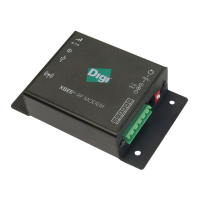XBee® Wi-Fi RF Modules
© 2013 Digi International, Inc. 63
Working with Flash Memory
When working with the General Purpose Memory, the user should be aware of a
number of limitations associated with working with flash memory:
• Flash memory write operations are only capable of changing binary 1's to binary
0's. Only the erase operation can change binary 0's to binary 1's. For this reason
it is usually necessary to erase a flash block before performing a write
operation.
• A flash memory block must be erased in its entirety when performing an erase
operation. A block cannot be partially erased.
• Flash memory has a limited lifetime. The flash memory on which the GPM is
based is rated at 20,000 erase cycles before failure. Care must be taken to
ensure that the frequency of erase/ write operations allows for the desired
product lifetime. Digi's warranty will not cover products whose number of erase
cycles has been exceeded.
• Over-the-Air firmware upgrades (described in the next section) require the
entire GPM be erased. Any user data stored in the GPM will be lost during an
over-the-air upgrade.
Over-the-Air Firmware Upgrades
The XBee Wi-Fi RF modules provide two methods of updating the firmware on the
module. Firmware can be updated locally via X-CTU (a free testing and configuration
utility provided by Digi) using the radio's serial port interface. Firmware can also be
updated using the radios' RF interface (Over-the-Air Updating.)
The over-the-air firmware upgrading method provided is a robust and versatile
technique which can be tailored to many different networks and applications. It has
been engineered to be reliable and minimize disruption of normal network operations.
There are three phases of the over-the-air upgrade process: distributing the new
application, verifying the new application, and installing the new application. In the
following section the node which will be upgraded will be referred to as the target node.
The node providing the update information will be referred to as the source node. In
most applications the source node will be locally attached to a PC running update
software.
Distributing the New Application
The first phase of performing an over-the-air upgrade on a module is transferring the
new firmware file to the target node. The new firmware image should be loaded in the
target node's GPM prior to installation XBee Wi-Fi RF modules use an encrypted binary
(.ebin) file for both serial and over-the-air firmware upgrades. These firmware files are
available on the Digi Support website.

